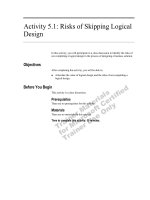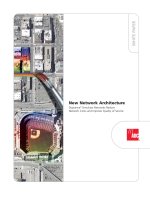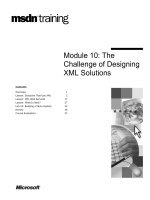Tài liệu US CELLULAR HELPS UNIVERSITY OF WISCONSIN HOSPITAL IMPROVE COMMUNICATIONS AND PATIENT SAFETY ppt
Bạn đang xem bản rút gọn của tài liệu. Xem và tải ngay bản đầy đủ của tài liệu tại đây (59.7 KB, 4 trang )
THE SITUATION
Several years ago, University of Wisconsin Hospital and Clinics in Madison,
Wisconsin faced a problem—doctors and staff were frustrated with poor wire-
less communications in and around the two million square foot complex. As a
Level One trauma center, clear and always available communications between
doctors, maintenance staff, patients’ families, and other emergency medical per-
sonnel was critical for quality care of patients.
The hospital complex itself was designed with patient safety in mind, a concrete
structure with towers between each wing for easy defense against fire.
However, this design proved difficult for wireless communications as doctors lost
calls as they walked through any door in the hospital complex.
As the same time, US Cellular, one of several wireless carriers in Madison, faced
its own problem. On the University of Wisconsin - Madison campus, cellular
coverage was weak. The UW campus is located between downtown Madison,
to the East, and the Hospital, to the West. While the business case warranted a
new cell site, there were no locations available for constructing a new tower,
and the University would not permit wireless carriers to locate antennas on any
of their properties. In fact, UW Hospital was one of the few landowners in the
search area not directly controlled by the University system.
US CELLULAR HELPS UNIVERSITY OF WISCONSIN HOSPITAL
IMPROVE COMMUNICATIONS AND PATIENT SAFETY
CASE STUDY
THE SOLUTION
US Cellular won the contract to improve wireless communications throughout UW Hospital and
Clinics in what has turned out to be a win-win partnership. The project included the following:
• US Cellular earned permission to install a macro site on top of the UW Hospital complex to
improve coverage along the western edge of downtown Madison. In return, US Cellular was
responsible for designing, purchasing, installing, and maintaining a system to cover the UW
Hospital complex.
• The new macro site provided coverage for the top five floors of the hospital complex.
However, the macro site could only penetrate so many feet of concrete, leaving the bottom
three floors—including the emergency room, operating rooms, and many public areas—with-
out coverage.
• To cover the bottom three floors of the building, US Cellular installed ADC’s Digivance‚ RF
Transport System to redistribute RF signals within the complex. ADC designed and installed a
system of 27 remote antennas and Digital Remote Units throughout the bottom three floors
of the complex, all linked through Digital Expansion Units (DEU) to the Host Unit with optical
fiber cables.
• With the exception of a small amount of cabling within the complex, the entire project was
funded by US Cellular.
THE BENEFITS
“Our number one objective for this project was patient safety,” said Ruth Fankhauser, Assistant
Director of Information Systems at UW Hospital. “Our doctors felt strongly that poor wireless
communications within the complex posed a potential threat to patient safety. In addition, we
needed to balance availability of wireless communications within the building against possible RF
signal interference with hospital electronics and monitoring equipment,” she said.
With the macro site covering the top five floors and the Digivance in-building system covering the
bottom three floors, cell phones could operate at lower power, reducing the risk of cellular inter-
ference with hospital equipment. While testing organizations had recommended to UW Hospital
that cell phones should be kept three inches from hospital equipment, the UW Hospital staff
imposed a three-foot restriction so people would be more conscious of cell phone use around
medical equipment.
US Cellular chose ADC’s Digivance RF Transport System for several reasons, according to Ken
Drake, Senior RF Engineer, and Al Remondini, RF Design Engineer, both of US Cellular. First, the
size of the project demanded an RF transport system that used fiber cables. “Within the building
there were so many floors and special areas to cover, including stairwells and hallways, that we
needed the longer reach of a fiber system,” said Drake. RF transport systems that rely on copper
cables have distance limitations that make copper impractical for large projects, he said. The dis-
tance limitation of a coax feeder cable was also an issue for the macro site.
CASE STUDY
CASE STUDY
Second, design flexibility made Digivance a clear choice for the project, according to Remondini.
“Digivance is one of the few indoor systems that does not require a home run to a central location
for each digital remote unit and antenna,” said Remondini. Digivance affords design flexibility
through use of Digital Expansion Units. Instead of a home run topology, DEUs are installed through-
out the complex, each of which serve up to six Digital Remote Units and antennas. ADC designed
the UW Hospital in-building system so that each DEU had one open port, allowing easy addition of
another antenna or DEU, for multiple antennas. This daisy chain topology works because
Digivance—the only all-digital RF transport system on the market today—is able to perfectly replicate
the digitized RF signal over each port on each DEU and Digital Remote Unit throughout the system.
This flexibility continues to prove useful for both US Cellular and UW Hospital. “No matter how
much you test, you always find coverage issues after turn-up because of the unique construction
characteristics of each building. It is a lot easier to add coverage with Digivance, both in terms of
cabling and man hours, than with other systems,” said Drake.
On top of the hospital, a three-sector macro site was placed to improve wireless service to the west
end of the downtown Madison area. While one sector could be easily located just outside the equip-
ment room, the other two sectors needed to be placed on the other side of the building, approxi-
mately 2000 feet away. This distance could not be accommodated with a traditional coax feed, so
US Cellular again turned to ADC for its Digivance RF Transport System. The Digivance macro solution
can transport RF over a fiber optic cable up to 12 miles without the attenuation issues incurred over
coax. This provides even more flexibility in optimizing site location.
Finally, US Cellular found that ADC offered one of the few turnkey solutions on the market. ADC pro-
vided design and installation of both fibers and equipment for the Digivance in-building and macro sys-
tem. “The installation went very smoothly. There were no complaints, which says a lot when you con-
sider that they (ADC) had to work in sensitive areas in a 24x7 environment,” said Remondini.
THE PARTNERSHIP CONTINUES
Since the system went live, US Cellular has added two more Digivance macro systems to accommo-
date the carrier’s addition of a CDMA network to its existing TDMA and analog network. While
Digivance accommodates any modulation standard, US Cellular was unable to combine the systems
because of limitations on their antennas.
The expansion of the in-building RF transport system to accommodate new construction for such
projects as new surgical wards promise to be easy and cost-effective for US Cellular as a result of the
Digivance topology. In addition, UW Hospital has created an in-building rate plan with US Cellular
to provide doctors, maintenance personnel, and other staff with a high in-building minutes plan for
a small, set monthly fee—a plan that will continue to increase the number of subscribers on the US
Cellular wireless system. Even with incremental investment required to cover new areas of the hos-
pital complex, the return on investment remains compelling for US Cellular.
ADC Telecommunications, Inc., P.O. Box 1101, Minneapolis, Minnesota USA 55440-1101
Specifications published here are current as of the date of publication of this document. Because we are continuously
improving our products, ADC reserves the right to change specifications without prior notice. At any time, you
may verify product specifications by contacting our headquarters office in Minneapolis. ADC Telecommunications,
Inc. views its patent portfolio as an important corporate asset and vigorously enforces its patents. Products or
features contained herein may be covered by one or more U.S. or foreign patents. An Equal Opportunity Employer
1311703 12/04 Original © 2004 ADC Telecommunications, Inc. All Rights Reserved
Web Site: www.adc.com
From North America, Call Toll Free: 1-800-366-3891 • Outside of North America: +1-952-938-8080
Fax: +1-952-917-3237 • For a listing of ADC’s global sales office locations, please refer to our web site.
CASE STUDY









